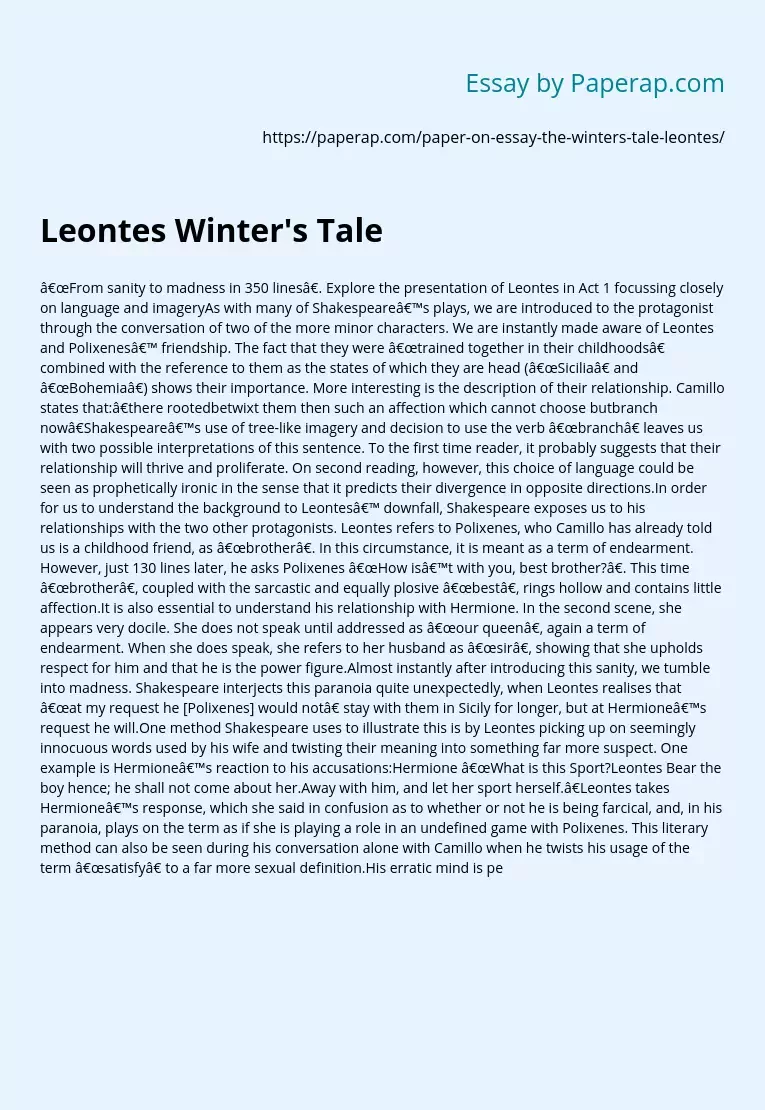Leontes Winter's Tale
“From sanity to madness in 350 lines”. Explore the presentation of Leontes in Act 1 focussing closely on language and imageryAs with many of Shakespeare’s plays, we are introduced to the protagonist through the conversation of two of the more minor characters. We are instantly made aware of Leontes and Polixenes’ friendship. The fact that they were “trained together in their childhoods” combined with the reference to them as the states of which they are head (“Sicilia” and “Bohemia”) shows their importance.
More interesting is the description of their relationship. Camillo states that:”there rootedbetwixt them then such an affection which cannot choose butbranch now”Shakespeare’s use of tree-like imagery and decision to use the verb “branch” leaves us with two possible interpretations of this sentence. To the first time reader, it probably suggests that their relationship will thrive and proliferate. On second reading, however, this choice of language could be seen as prophetically ironic in the sense that it predicts their divergence in opposite directions.
In order for us to understand the background to Leontes’ downfall, Shakespeare exposes us to his relationships with the two other protagonists.
Leontes refers to Polixenes, who Camillo has already told us is a childhood friend, as “brother”. In this circumstance, it is meant as a term of endearment. However, just 130 lines later, he asks Polixenes “How is’t with you, best brother?”. This time “brother”, coupled with the sarcastic and equally plosive “best”, rings hollow and contains little affection.It is also essential to understand his relationship with Hermione.
In the second scene, she appears very docile. She does not speak until addressed as “our queen”, again a term of endearment. When she does speak, she refers to her husband as “sir”, showing that she upholds respect for him and that he is the power figure.Almost instantly after introducing this sanity, we tumble into madness. Shakespeare interjects this paranoia quite unexpectedly, when Leontes realises that “at my request he [Polixenes] would not” stay with them in Sicily for longer, but at Hermione’s request he will.One method Shakespeare uses to illustrate this is by Leontes picking up on seemingly innocuous words used by his wife and twisting their meaning into something far more suspect. One example is Hermione’s reaction to his accusations:Hermione “What is this Sport?Leontes Bear the boy hence; he shall not come about her.Away with him, and let her sport herself.”Leontes takes Hermione’s response, which she said in confusion as to whether or not he is being farcical, and, in his paranoia, plays on the term as if she is playing a role in an undefined game with Polixenes.
This literary method can also be seen during his conversation alone with Camillo when he twists his usage of the term “satisfy” to a far more sexual definition.His erratic mind is perhaps best illustrated in one of his initial speeches. As with “sport” in the previous extract, Leontes picks up on his own use of the verb “play”. He switches from telling his son to innocently “go, play, boy, play” to a far more sinister “your mother plays” in one single line. This erratic mind is also illustrated through Shakepeare’s use of syntax. Some lines, such as the first three, a regularly punctuated and contain caesuras causing a reader to speak in a rapid and erratic manner. Equally, the seventh to fifteenth line contains one long sentence with little punctuation. The lack of pauses causes the sentence to pick up pace and sound equally as insane as the previous lines.His choice of language is equally effective on an aural level. He juxtapositions the sibilant sounds of “issue” and “hiss” with the plosive sounds of “contempt and clamour”. This contrast of tones aids the speech’s erratic overtones.Leontes’ paranoia is perhaps best illustrated through his use of very exaggerated imagery, which, juxtapositioned with his term of endearment a few lines prior, show his deteriorated state. In this speech, Shakepeare uses metaphors relating to an invaded piece of property. His references to a “gate opened” and a “barricado”, show how he considers Hermione to be a possession, which has been taken from him.
He also portrays Hermione using imagery relating to the lowest and least respected members of their society. He calls her a “hobby-horse” (whore) and “as wrank as any flax-wench”. These terms are shocking images for the audience to be presented with when, on stage, Hermione seems a respectable queen. This shock is shown by Camillo who, when confronted with Leontes’ suspicion, feels he must defend his queen referring to her as his “sovereign mistress”. Further imagery such as “sluiced” has an equally shocking and vulgar effect.His use of similes is very effective. He announces that women “will say anything” and that they are false as “o’er-dyed blacks, as wind, as waters, false as dice are to be wished by one that fixes”. These extensive exaggerations show his insanity because, as a member of the audience who can tell that his wife’s liaisons are completely fictitious, can see the dramatic irony of how detailed he is about something false and how obsessive he is becoming. As the speech containing the aforementioned extract continues, he continues to use repetition and questions, which emphasise his confused state.Once he has become undoubtedly paranoid, it would be easy for the audience to forget his initial state, thus making his paranoia seem less of a change. In order to overcome this hurdle, Shakespeare juxtapositions his short, direct and rational commands when in company (“You, my lords, look on her and mark her well”) with his rambling, overstated speeches. Many of his speeches are presented as asides. This has the effect of separating his thoughts from the ‘real world’ and emphasising to the audience that this entire saga is purely part of his imagination.Through his careful juxtapositions and use of exaggerated language and imagery, Shakespeare successfully presents the downfall of Leontes in a single scene.
Leontes Winter's Tale. (2019, Dec 05). Retrieved from https://paperap.com/paper-on-essay-the-winters-tale-leontes/

